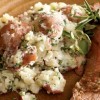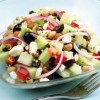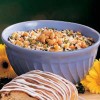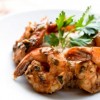Cool Soba with Shrimp, Napa Cabbage, and Cilantro

3 tablespoons soy sauce
¼ cup sake or dry sherry
1½ teaspoons grated fresh ginger
1 pound medium shrimp, shelled and deveined
2 tablespoons rice vinegar
1 teaspoon sugar

3 tablespoons soy sauce
¼ cup sake or dry sherry
1½ teaspoons grated fresh ginger
1 pound medium shrimp, shelled and deveined
2 tablespoons rice vinegar
1 teaspoon sugar

Freshly dug, true “new” potatoes are so creamy and flavorful they hardly need any additional ingredients to make them spectacular. Here we tumble them with a bit of butter, tangy yogurt, scallions and just-chopped fresh parsley. If new potatoes are not available, use any small red potatoes.

An easy salad to serve with grilled chicken or steak for supper or on a bed of greens for a satisfying lunch. Substitute white beans or chickpeas for the black-eyed peas if you prefer.

Cashew pilaf is a beautifully textured mix of nutty wild rice and tender long grain white rice, studded with tiny cubes of sautéed carrots, onions and, at the end, a lavish toss of minced parsley and roasted salted cashews. It has softness and crunch, sweetness and saltiness.

Visit a farm or stand and bring home a basketful of native vegetables. Then trim, snip, and simmer them into a large pot of vegetable soup. Let the kids select their favorite vegetables (everyone likes corn, many like green beans); introduce one or two that may not have gone over well in the past (zucchini).

Naan, the large flat Indian bread, makes a fine pizza crust. It’s available in many specialty markets.

The magic in this dish happens in the spice grinder, where all the layers of flavor are brought together before cooking even begins. Serve with brown basmati rice.

Fresh corn is already at some farm stands and you only have a couple of months to get your fill. This is a favorite relish to spoon beside grilled chicken or fish. There is no easy way to remove the corn from the cobs. Do it several rows at a time with a serrated knife. To make shucking painless, pull off the husks at the farm stand (unless you need the compost).


The Italian word frittata derives from fritto, the past participle of "to fry" (friggere), and was originally a general term for cooking eggs in a skillet, anywhere on the spectrum from fried egg, through conventional omelette, to an Italian version of the Spanish tortilla de patatas, made with fried potato. Outside Italy, frittata was seen as equivalent to "omelette" until at least the mid-1950s.